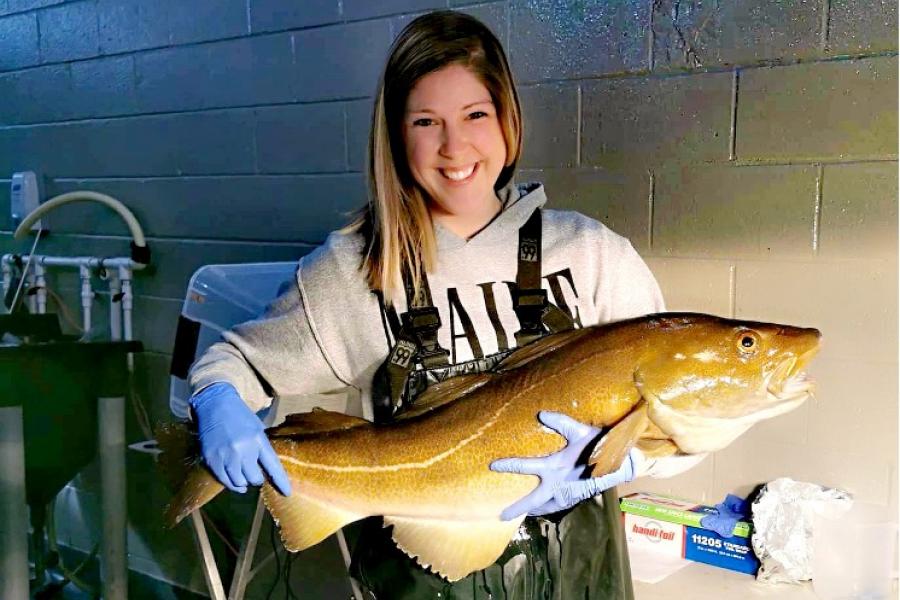Student Research Profile: Rebecca Eldridge
The Department of Environment and Geography is proud to highlight recently published graduate student research.
THE STUDENT
Rebecca Eldridge is just about to finish her MSc in Aquatic Ecotoxicology in the Department of Environment and Geography, co-supervised by Dr. Mark Hanson and Dr. Benjamin de Jourdan (of the Huntsman Marine Sciences Centre). Rebecca completed her undergraduate degree at Dalhousie University in 2016 with a double major in Environmental Sustainability and Environmental Science.
Rebecca has always been passionate about nature and environmental issues. She was a part of a program in her high school called Envirothon, students from around the province gathered to compete on environmental science activities. Rebecca says, “I think that’s where I first realized I wanted to pursue the field. Being passionate about the outdoors, wildlife, and all manner of flora and fauna has made me want to protect the environment and choose a career path that would contribute meaningfully to conservation.”
THE RESEARCH
Rebecca’s paper, A Critical Review of the Availability, Reliability, and Ecological Relevance of Arctic Species Toxicity Tests for Use in Environmental Risk Assessment, published in Environmental Toxicology and Chemistry, explored Arctic species toxicity tests based on their availability, reliability, and ecological relevance. Rebecca says that the study demonstrates “that there are very little data in the literature in general using Arctic test species, and far less of these data were considered reliable for use in environmental risk assessment based on a set of criteria and scoring system we developed.” The study highlights the need for researchers to collect high-quality, reliable ecotoxicity data that is relevant to the Arctic to ensure risk assessments in northern regions are adequate so that their ecosystems can continue to thrive.
Rebecca highlights that the Arctic is particularly understudied in terms of species sensitivity. She states that “this region has seen a huge increase in shipping, oil and gas exploration, and human settlements over the last couple of decades and this brings with it more risk of contamination and pollution. There will always be a level of risk to aquatic organisms as a result of human activities but understanding how they respond to contaminants helps us manage these risks in such a way that populations and ecosystems can continue to function.” She adds that the impacts contaminants have on our environment are critical to understand since human activities drive so much of the changes we are currently seeing and experiencing.
THE PUBLISHING
How did you select the journal to publish in? As a student member of the Society for Environmental Toxicology and Chemistry and a previous board member of the North American Student Advisory Council for SETAC, publishing in ET&C has always been a priority for me. The subject matter of the review we conducted is a perfect fit for the focus and readership of this journal, and since a large part of the paper involved identifying knowledge gaps and future research needs for Arctic marine ecotoxicology, it was our hope that these recommendations would reach the right people by publishing here.
What did you think of the reviewer comments? The reviewer comments were critical to the success of the paper. Having outside eyes review work that you’ve seen over and over for months is really helpful in catching things that you’ve missed. Aside from that, having a different perspective weigh in on research that you’re passionate about helps fill in any gaps in logic or rationale, which helps ensure that published papers are backed in high-quality science. I learned a lot about my own research by addressing the reviewer comments and feel that it made me better prepared to defend the work we accomplished.
How did you find the process overall? Working full-time while conducting and writing this review was definitely a challenge, but really helped me hone my skills in multi-tasking and focusing. When it came to publishing, it was really smooth from my end – largely due to the mountains of help my advisors provided throughout the process. This is the first article I have ever published so there was a lot to learn about how publication works, with lots of surprises throughout, but having excellent mentors to guide me through it made it seem like a breeze!
THE TAKE-HOME ADVICE
“Be critical of the literature you read. Before citing a paper, analyze the different components of their study and make sure the data you’re referencing is reliable for your purposes. It’s easy to get discouraged if you get a lot of reviewer comments when you’ve worked so hard on something, but it’s important to understand that in the end, it will not only make your paper better but will make you a better researcher with a more well-rounded perspective.”
CONTACT
Rebecca Eldridge, Master’s Student
Department of Environment and Geography
University of Manitoba
Email: eldridgr@myumanitoba.ca
THE PAPERS
Eldridge, R.J., de Jourdan, B.P. and Hanson, M.L. (2021). A Critical Review of the Availability, Reliability, and Ecological Relevance of Arctic Species Toxicity Tests for Use in Environmental Risk Assessment. Environmental Toxicology and Chemistry, 41(1), 46-72.
https://doi.org/10.1002/etc.5247
Interview by Katarina Djordjevic

